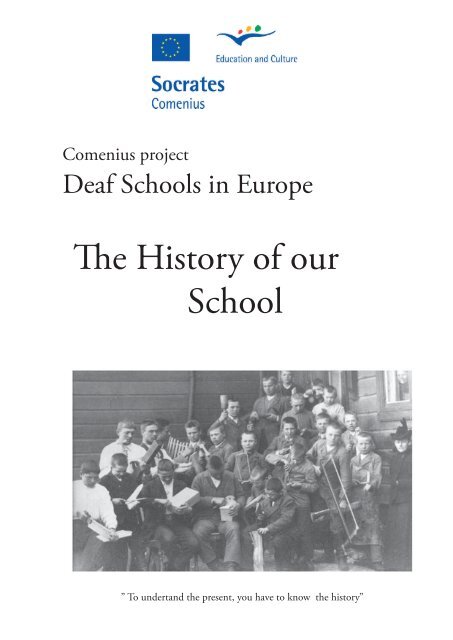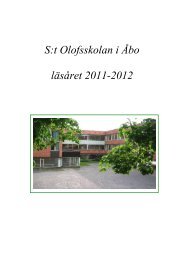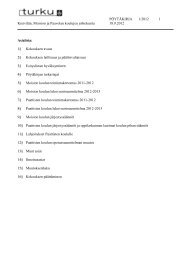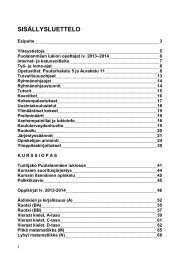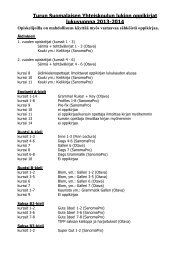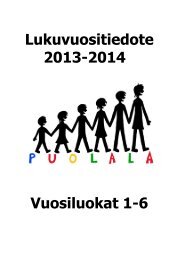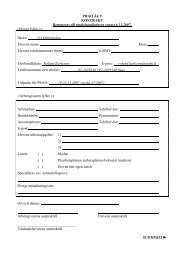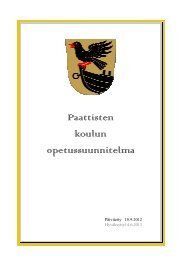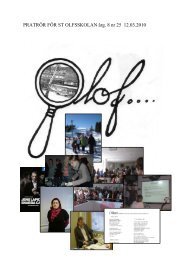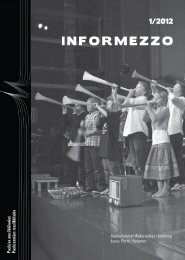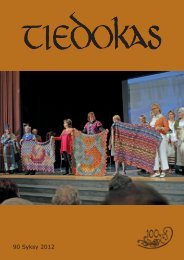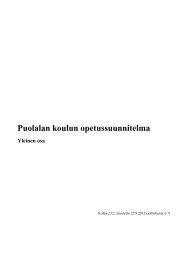Create successful ePaper yourself
Turn your PDF publications into a flip-book with our unique Google optimized e-Paper software.
Comenius projectDeaf Schools in EuropeThe <strong>History</strong> of ourSchool” To undertand the present, you have to know the history”
This <strong>booklet</strong> is one of the outcomes of a Comenius project and has beensupported by the European Comission. It tells about the history of deafeducation in six different countries in Europe.The project participants agreed that it is important to write down glimpsesof deaf education because it is undergoing great changes in theworld. The number of deaf students is decreasing in many countrieswhen new technologies offer other choices such as cochlea implants.Since deaf education goes hand in hand with the history of the deaf ,this <strong>booklet</strong> gives us also information about deaf history in general. Everyschool has written down the history of their own school.The participating countries and schools in the project have been:Finland and C.O.Malm School in <strong>Turku</strong>,Germany and Carl-Orff-Schule in Lingen,Greece and the Special High School for the Deaf and the Hard ofHearing of Thessaloniki,Italy and the Direzione Didattica di Cossato School in Cossato,Spain Centro Especifico de Educacion Especial C.Apy . I. Sordos RosaRelano,in Almeria,Sweden and Nya Broskolan in Stockholm.
The <strong>History</strong> of C.O.Malm SchoolCarl Oskar Malm(12.2.1826 - 8.6.1863)C.O.Malm school will be 150 years oldon 20th of January 2010.A war officer Anders Gustaf Malm living in Porvoo, sent in the 1830 ‘s his deaf 8-year-old son to Stockholmto go to school. At that time we had no deaf schools in Finland yet. Malm was a very gifted studentin Manilla school in Stockholm. After his studying Malm returned to his home country Finland to start thedeaf education.The first deaf school functioned in Porvoo in his father’s house. This private deaf school was supported byMalm’s father and a group of famous people in Porvoo, such as the national poet of Finland, J.L.Runebergand pastor Alopaeus.
The Russian emperor Alexander II gave a declaration to start with state funds a deaf school in <strong>Turku</strong>.Carl Oskar Malm was the teacher in the school and his lawyer brother, Gustaf Emil Malm, was theheadmaster. Thus C.O.Malm became the starter of <strong>Turku</strong> deaf school and the father of deaf educationin the whole Finland.According to the regulation for the <strong>Turku</strong> Deaf and Dumb School, the aim was to teach knowledgeto pupils. The school also had to educate and teach for life and to give the students a possibility tolearn an occupation. The boys were apprenticed to carpenters, tailors and shoemakers and the girlslearned to do household tasks and weaving. The students lived in various homes with full boardingin <strong>Turku</strong>, at school, in a small boarding house or they were sent as apprentices to handicraft workers.The minimum goal of education was to go to confirmation classes and to be confirmed. This is whypart of the older students stayed in the school for only one year. The students were accepted fromall over Finland, all the way from Vyborg and Åland. The first 22 students to start the school werebetween 9 to 27-years.The <strong>Turku</strong> Deaf School faced a big sorrow when the beloved teacher Carl Oskar Malm died atthe age of 37, after being a teacher for just over 3 years. The headmaster at that time, Carl HenrikAlopaeus, chose Malm’s former student, David Hirn, to be his successor. This deaf cartographer andphotographer wanted to teach in sign language in a time when speech method became more andmore common in European deaf schools.When pastor A.Eliel Nordman was the headmaster (1881-1918) the use of sign language as teachinglanguage was replaced with speech method, and the school got its own building on Ryssänmäki.Deaf teachers and sign language were put aside for almost a hundred years.Many children had not met other deaf people before coming to school, so life in the dormitory wasvery important for them. The students travelled home for holidays.
A teacher education programme for teaching hearing disabled, functioned also in <strong>Turku</strong> deaf schooland the headmaster Emil Pesonen was also the headmaster for this seminar school. Pesonen alsomade schoolbooks for the deaf. After him, in 1935, Urho Kierimo was nominated as the new headmasterfor the next 22 years.Although sign language was forbidden as the teaching language, it was in use among the deaf, partlyin secret. The priests for the deaf worked for the sign language. In the 1960’s, sign language was littleby little accepted again. It became the standard teaching language in <strong>Turku</strong> in 1963, when AimoKangas started as a headmaster.In 1972 there was a new law about organizing communal deaf education. It was thought that insteadof living in a dormitory, it was better for the children to live at home and go to school from there.The state funded <strong>Turku</strong> deaf school was ended in 1972. It was replaced with the <strong>Turku</strong> School forHearing Disabled, which was under the <strong>Turku</strong> schooling board like other schools. A class for hardof-hearingstudents was also founded in this new school. The new headmaster for the next 20 yearswas Hannu Ansaharju.In 1980 the school building in Ryssänmäki was taken in use by the University. The school for hearingdisabled moved into temporary locations in Mestarinkatu for 8 years. The new school building,where the school is today, was ready in Hannunniittu area in 1988.Anneli Suomi has been the headmaster since 1995.In 1998 the name of the school was changed to C.O.Malm school.Today C.O.Malm School has about 120 pupils between 5-18 years. The students are deaf, hearingimpaired or dysphatic. Teaching languages vary according to the students’ needs between sign languageand spoken Finnish or speech supported with signs. The school offers also support services andexpertise outside the school and is a place for practising for many students in the field of sign language.
C.O. MALMIN KOULUN HISTORIAAMalmin koulu täyttää 150 vuotta 20 tammikuuta 2010.Carl Oskar Malm(12.2.1826 - 8.6.1863)Porvoossa asuva sotakamreeri Anders Gustaf Malm lähetti 8-vuotiaan kuuron poikansa 1830-luvullaTukholmaan asti käymään koulua, koska tuohon aikaan ei Suomessa vielä ollut kuurojenkouluja.Tukholman Manilla-koulussa Malm oli erittäin lahjakas oppilas. Opiskeltuaan Ruotsissa Malm palasitakaisin kotimaahansa Suomeen aloittaakseen kuurojen opetuksen.Ensimmäinen kuurojen koulu sijaitsi Malmin isän talossa Porvoossa. Tätä yksityistä kuurojenkouluatuki Malmin isän lisäksi joukko tunnettuja porvoolaisia, kuten Suomen kansallisrunoilija J.L. Runebergsekä pastori Alopaeus.Venäjän keisari Aleksanteri II antoi julistuksen valtion varoilla toimivan kuurojen koulun perustamiseksi<strong>Turku</strong>un. Carl Oskar Malm toimi koulun opettajana ja hänen veljensä, varatuomari Gustaf EmilMalm koulun johtajana. C. O. Malmista tuli siis Turun kuurojen koulun opetuksen käynnistäjä jasamalla koko Suomen kuurojen opetuksen isä.Turun kuuromykkäin koulun ohjesäännön mukaan koulun tehtävänä oli antaa kuuroille tiedollistaopetusta. Koulun tuli myös kasvattaa ja opettaa elämää varten, ja oppilaille tuli antaa mahdollisuusopetella jokin ammatti. Pojat olivat puusepän, räätälin ja suutarin ammattiopissa, ja tytöt opettelivatkotitaloustöitä ja kudontaa. Oppilaat majoitettiin täysihoitoon turkulaisiin koteihin, oppipojiksikäsityöläisten luo, koululle tai pieneen asuntolaan.
Koulunkäynnin vähin tavoite oli rippikoulun suorittaminen. Siksi osa iäkkäimmistä oppilaistaoli koulussa vain yhden lukuvuoden. Oppilaita kouluun otettiin koko maasta, Viipurista jaAhvenanmaalta asti. Koulun aloittikin heti 22 oppilasta, joista nuorin oli 9-vuotias ja vanhin 27-vuotias.Turun kuurojenkoulua kohtasi suuri suru kun rakastettu opettaja Carl Oskar Malm kuoli 37-vuotiaanaoltuaan Turun koulun opettajana vain runsaat kolme vuotta. Silloinen koulun johtaja Carl HenrikAlopaeus valitsi Malmin seuraajaksi Malmin entisen oppilaan, David Hirnin. Tämä kuuro kartanpiirtäjäja valokuvaaja halusi opettaa viittomakielellä aikana, jolloin puhemetodi yleistyi Euroopassa.Pastori A. Eliel Nordmanin johtajakautena (1881-1918) koulu muuttui viittomakielisestä koulustapuhekouluksi ja sai vihdoin oman koulurakennuksen Ryssänmäellä. Kuurot opettajat sekä viittomakieliopetuskielenä jäivät syrjään lähes sadaksi vuodeksi.Asuntolaelämä oli syrjäseuduilta kotoisin oleville kuuroille tärkeä asia, koska monet lapset eivät olleet ennenkouluun tuloaan tavanneet koskaan aikaisemmin toista kuuroa. Loma-ajoiksi oppilaat matkustivat kotiin.Turun kuurojen koulussa toimi myös Turun kuuromykkäinkoulun opettajainvalmistuslaitos, jonkajohtajana toimi koulun johtaja Emil Pesonen. Hän teki myös oppikirjoja kuuroille. Pesosen jälkeenkoulun johtajaksi nimitettiin vuonna 1935 Urho Kierimo. Hän oli koulun johtajana 22 vuotta.Vaikka viittomakielen käyttö kuurojenopetuksessa oli kielletty, viittomakieli oli kuitenkin käytössä,osittain salaa, kuurojen keskuudessa. Kuurojenpapit tekivät omalta osaltaan työtä viittomakielenpuolesta. Viittomakieli alettiin vähitellen hyväksyä 1960-luvulla; opetukseen se vakiintui Turunkuurojenkoulussa vuodesta 1963 alkaen, jolloin johtajaksi tuli Aimo Kangas.Vuonna 1972 voimaan tuli laki kunnallisista kuulovammaisten kouluista. Ajateltiin, ettäsisäoppilaitoselämän sijasta lasten olisi parempi asua kotona ja käydä koulua kotoa käsin. Valtionylläpitämä Turun kuurojenkoulu lakkautettiin vuonna 1974 ja tilalle perustettiin Turun kaupunginkoululaitokseen kuuluva Turun kuulovammaisten koulu. Kouluun sijoitettiin myös huonokuuloistenluokka. Rehtoriksi nimitettiin Hannu Ansaharju. Hän oli koulun rehtorina 20 vuoden ajan.Vuonna 1980 Ryssänmäen koulurakennus otettiin yliopiston käyttöön. Kuulovammaisten koulu siirtyiväliaikaisiin tiloihin Mestarinkadulle kahdeksaksi vuodeksi odottamaan nykyisen koulurakennuksenvalmistumista. Uuteen viihtyisään koulurakennukseen Hannunniittuun pääsimme muuttamaansyksyllä 1988.Anneli Suomi on ollut koulun rehtorina vuodesta 1995 alkaen.Vuonna 1998 muutimme koulun nimen. Kuulovammaisten koulu muuttui C.O. Malmin kouluksi.Nykyään C.O.Malmin koulussa on n. 120 oppilasta. He ovat kuuroja, huonokuuloisia tai kielihäiriöisiäoppilaita. Opetuskielenä käytetään viittomakieltä sekä oppilaiden tarpeiden mukaan tukiviittomiapuhutun kielen tukena. Koulu tarjoaa myös tukipalveluita ja asiantuntija-apua koulun ulkopuolellesekä toimii harjoittelupaikkana monille viittomakielialan opiskelijoille
A historic overview of the German education for the hearing impairedRegina Hannemann, Anja Kersten, Ulrike SchaubIIntroductory thoughtsPeople with hearing disabilities have been around since the beginnings of the human race. Yet, what about theeducational opportunities for the hearing impaired?Schools and a chance for serious education have not always been on offer to them.Until the beginning of the 20th century, there was merely some education for the deaf and the mute, whichincluded the hearing impaired and the speech impaired. This was probably due to the lack of diagnosticallymethods for a differentiated approach.The specific fields of education for the deaf, the hearing impaired and the speech impaired took some time todevelop.Since its inception, the education for the hearing impaired worldwide has strived to achieve its main goal toassist hearing impaired children in finding a form of communication.This goal, however, is jeopardised by global discrepancies between the expectations of the hearing societytowards the young hearing impaired, and the abilities of the individuals in question. Faced with this generaltension, the question about the “right” method for teaching a form of communication has been the focus ofdiscussion among specialists in the field.The following will show the historical development of the German education for the hearing impaired,primarily focussing on the didactic-methodical concepts of teaching a form of communication. Beginningwith the presentation of the historical methods of communication, which are rooted in the ‘German Method’and are closely connected with the name of Samuel Heinicke, this essay will then introduce the gradualdevelopment of the educational methods.Finally, present viewpoints on education for children with learning disabilities will be briefly reflected uponfrom a modern perspective.IIThe Beginning of the education for hearing impaired childrenThe basic idea at the beginning of the education of the hearing impaired was that a targeted education of thechildren in question could only be achieved through the establishment of spoken language.Beginnings of the didactic education of the hearing impaired are found as early as the 16 th century. Underlyingwas a new and pioneering finding by the Italian mathematician, doctor and philosopher HieronymusCardanus (1501-1576). He ascertained that the deaf are indeed – contrary to the prevailing opinion – able tobe educated. He acknowledged the interrelation between deafness and muteness, and he made the distinctionbetween various kinds of hearing impediments.Meanwhile, the Spanish monk Ponce de Leon (1510-1584) was working on developing a concept for a languagebased on phonetics for the first time. He developed spoken language using written language in combinationwith a one-handed finger-alphabet. Bonet and Carrion felt the need to further develop and systematise thisapproach in order to find a scientific founding on which to base the procedure, which they then named the“Spanish Method”.
Around 1700, the teaching of spoken language was systemised by Johann Conrad Ammann (1669-1742),who focused on the physiology of spoken language, thus moving the predictability of sounds into the centreof attention of his cohesive procedure.The development of phonetics was primarily supported by written language, lip reading and partially also thefinger-alphabet, until the German teacher Samuel Heinicke (1727-1790) discovered the kinaesthetic sensationof linguistic movement as a replacement for the lack of hearing. Heinicke believed that the kinaestheticsensation of linguistic movement was the internal link between the thought and the spoken word. Based onthis and for the first time since the beginnings of the education of the hearing impaired, he called on spokenlanguage to be employed as the only means within the education of those concerned in order to pave theirway into becoming members of the higher society. His major contribution lies in the fundamental linguisticpsychologicalfoundation of the “oral method” as a procedure for linguistic construction.As the founder of the “German method”, Heinicke maintained that the hearing impaired were only able tofully partake in society if they acquired the use of spoken language.Based on the belief that the hearing impaired were lacking a sense, which needed to be replaced by another,Samuel Heinicke invented his own learning method, which has been documented in the “Arcanum”. By usingthe sense of taste, it appeared to be effective to trigger, stabilise and consolidate articulate sounds with the helpof specific liquids. The idea was to exercise the use of vowels via the sensation of taste: “a” via clear water; “e”via wormwood extract; “i” via sharp vinegar; “o” via sugared water, and “u” via tree oil. In addition, the senseof touch played an important role in the teaching and education of the deaf. Today, the “Arcanum” is no longerbeing taken into consideration.The first school for the hearing impaired sprang into life in 1778 in the German city of Leipzig, and it has beennamed after its founder Samuel Heinicke.The first controversy on methods originated between Samuel Heinicke and his contemporary Abbe de l’Epee,who was the advocate of the so-called “French method” in Paris. The controversy was triggered by de l’Epee’sconviction that sign language took the place of a mother tongue for the hearing impaired since they could notdevelop a natural appreciation for spoken language based on hearing.Due to Heinecke’s initiative in the field of the then so-called education for the deaf and the mute, numerousschools for the hearing impaired (institutions for the deaf and the mute) were, among others, founded in thefollowing years: 1784 in Karlsruhe, 1787 in Schleswig, 1799 in Kiel, 1804 in Munich, and 1835 in Halle.These followed either the manual method (sign language) from Paris or the oral method (spoken language)from Leipzig.Whilst at first the manual method was being favoured, the procedure changed in many German-speakingcountries towards the second half of the 19 th century in favour of the oral method.The most significant teachers for the hearing impaired in this era were Moritz Hill (1805-1874) and JohannesVatter (1842-1916). Both educationists were regarded as supporters of the “pure phonetical method”, andthey practised their teaching accordingly. Although their choice of contents differed, there was no questioningthe ways of teaching and application through spoken language. Nevertheless, controversial discussions on theeffectiveness of teaching spoken language versus education based on sign language continued.
Eventually, the controversy came to an end at the “2. International Conference of Deaf-Mute” in Milanin 1880. The decision to give preference to the method of spoken language was nearly unanimous as mostparticipants were convinced of this method’s implicit superiority.In the second half of the 19 th century, the hearing impaired began to set up associations, which were callingfor autonomous rights with regard to decisions on their education.They demanded the right to use sign language in both every day life as well as in the course of their education.A major advocate of this movement was Johann Heidsieck (1855-1942).The turn of the century was dominated by the endeavours for educational reforms, which lead to a criticalassessment of the “pure oral method”. Significant impulses for the changes were initiated on the one handby the so-called “typeface advocates” (e.g. Forchhammer and Goepfert), who believed that an early focus onwritten words would be the basics for articulation, reading and vocal expression, and on the other hand by thedevelopment of the mouth-hand system (also Forchhammer).Querll (1923) was offering a similar concept to the education of spoken language in his “Development oflanguage and speech in the mother school”. The special feature of this concept was the integration of theparents into the education of spoken language as well as the call for a pre-school support in kindergarten.On the other side of the spectrum were those conceptions that accorded a central function to the hearingimpression, which could be mediated through the remaining hearing assisted by technical devices. Basedon the preceded discovery of the hearing remainders (Bezold and Urbantschitsch, 1896), a new approachpresented itself, whose methodical use became clear during the second movement for hearing education. Inthe course of the systematic technical development of hearing aids and neurophysiological findings on thedevelopment of hearing and speech, the need for early support became established and officially recognised. Itwas agreed that the opportunity of educating a hearing impaired child early was an inevitable pre-requisite inorder to take advantage of the infantile aptitudes for the natural development of speech.Until now, Van Udens and Schmid-Giovannini had a guiding influence on the establishment of the earlyhearing education based on spoken language. In the centre of van Uden’s approach is communication, as wellas facing the person opposite in order to facilitate an optimal integration of the hearing impaired child intothe world of the hearing.Lip-reading, vibro-tactile and kinaesthetic sensations, the hearing imprint and an early learning how to readwere used as teaching methods.Schmid-Giavannini’s method also incorporated basic ideas of an early hearing education, and this representeda decisive component of the unisensoric - oral conception.This accords priority to the provision with a hearing aid as well as a well-aimed hearing education as soon aspossible.Parallel to the methods in the hearing and speech education, concepts have been developed since 1975, whichprefer the functionality of sign language (LBG, LUG and DGS). Ramme, Wudtke, Wisch and Prillwitzbased their arguments on unsatisfactory results of the phonetic education, which were dominated by the oralmethod.These authors regarded it as necessary to offer children with hearing impairment an alternative based onsign language in order to give them unhindered access to understanding contents, and a more relaxedcommunication.Picking up this thread, the University of Hamburg as well as the Humboldt University in Berlin are currentlyresearching a bilingual conception of learning language for children with hearing impairment. This involveslearning both sign language and spoken language on an equal basis from birth.
IIIConclusive thoughtsCurrent methods have modified the traditional knowledge of oral education due to neurophysiologic findingsin the development of hearing and speech. With the help of technical hearing aids, acoustic information canbe passed on to babies, thus supporting the teaching of speech within the timings of the natural phases ofspeech development.The establishment of diagnostic, provision with hearing aids, and educational intervention at the earliest pointin time can be regarded as the achievements, which have been drawn from the further development of the“oral education” into an “oral-aural education“. The consequences are, on the one hand, an approach of theeducation for the deaf and the hearing impaired, and on the other hand an increasing heterogeneity of thosechildren with hearing impairments.The original question about the “correct” method, i.e. about the textual structure of the education, still playsan important role in the German education for the hearing impaired.Finally, the question arises as to whether the conceptional procedure should still be held in high regard, orwhether an education based on the possibilities and abilities of the child should be given priority.IV<strong>History</strong> of the Carl-Orff-SchoolThe school for the speech disabled was founded in 1976 in Lingen and moved into its first premises in thebuildings of the former Primary and Secondary Comprehensive Broegbern in Lingen. This was achievedthrough the efforts of the schoolteacher for special needs children Edmund Foerstermann in the previous years,who wanted to create an educational choice for the pupils with speech impairments in the area of Lingen. Since1975, this initiative had been supported by the parents of children with hearing impairments, who wantedto avoid putting their children into the boarding school at the Educational Centre for the Hearing Impairedin the distant Osnabrueck. One year after its foundation, the school’s name was changed into “School for theSpeech Disabled and the Hearing Impaired”.Edmund Foerstermann was appointed headmaster, a position he held for 16 years until his retirement on 23 rdJune 1992. After the temporary direction by Friedrich Kirchelle, the position of headmaster was filled againafter one year by Hermann Heynck on 15 th June 1993.In the schooling year of 1997-98, the institution was named “Carl-Orff-School”.The school feels a special bond with this German composer, who strived to develop unity between music,speech, and movement in his musical works.What originally started as only one class quickly developed into an entire primary school. In August 1980,a pre-school with 11 pupils was added to the classes for the speech impaired and the classes for the hearingimpaired. In August 1994, this pre-school was transformed into a school nursery, which was visited by childrenwho had reached schooling age, but who seemed unlikely to be able to successfully attend their first schoolyear.Since the schooling year of 2000/01, the nursery has been transformed into the beginners’ stage so- calledEingangsstufe. Since then all children are being accepted into the Eingangsstufe where they are being taughtaccording to their individual stage of development.
The Carl-Orff-School has the educational profile of a transit school.This means that the pupils will leave the Carl-Orff-School as soon as possible, but at the latest after the fourthgrade, in order to change to a primary school or to a secondary school.Pupils with hearing impairment generally go to the Educational Centre for the Hearing Impaired in Osnabrueckor in Oldenburg.The Carl-Orff-School is a support centre. From its beginnings, tight co-operative links were maintainedrespectively with institutions of the federal government, the city, and the churches.Particular attention was given to the special speech education, which has been incorporated in the MobileSpeech Service since August 2005.The Mobile Hearing Service and the Mobile Physical and Motorical Development Service were set up in1995; in August 2005, the offer was extended to include the Mobile Seeing Service.In the current schooling year 2006/07, 84 pupils and seven learning groups are using the services of theCarl-Orff-School. There are 16 teachers and two trainee teachers looking after these pupils. Next to theircurriculum, all teachers also take part in these Mobile Services.Lit.:Leonhardt, Annette: Einführung in die Hörgeschädigtenpädagogik,Reinhardt- Verlag München 2002Vogel, Helmut: Geschichte der Gehörlosenbildung, www. Kugg. De
Cenni di storia delle Istituzionie dei metodi educativiper i Sordi in ItaliaAn outline of thehistory of Institutions andof educational methodsfor deaf people in Italy.In Italia, diversamente da altri paesi europei, il metodooralista ha avuto una lunga storia come sistemaideologico e prassi educativa nei confronti dellepersone sorde.Per Oralismo intendiamo l’insieme dei metodi diriabilitazione del sordo nei confronti della parola, enon del linguaggio e della comunicazione.Nella seconda metà dell’Ottocento, tutti gli istitutiper sordi adottarono il metodo oralista.In Italy, differently from the other European countries,the oralistic method has had a long history bothas ideological system and educational practise forthe deaf people.By Oralism we mean an ensemble of rehabilitationmethods for deaf people vis à vis the word, and notto language and communication.In the second half of 1800, all the schools for deafmutepeople adopted the oralistic method.The old Italian manual alphabetThe new Italian manual alphabet
Fino ad allora, nell’educazione dei sordi era semprestata usata la lingua dei segni per comunicare, inparticolare fra il Settecento e il secolo successivo.Dopo la scelta del metodo oralista, la lingua deisegni è stata considerata inadeguata e dannosa peri bambini sordi, in quanto impedirebbe il raggiungimentodel vero fine dell’educazione, cioè ilpossesso pieno della parola.Quindi, le esperienze e gli importanti contributicontenuti nel manuale per l’istruzione dei sordi diJ. P. Bonet pubblicato nel 1620 sono state messeda parte. In questo lavoro si illustra come Poncede Leon avesse istruito i tre figli sordi di un nobilespagnolo utilizzando i segni;si sono anche trascurate le esperienze che l’abateDe l’Epée, direttore dell’Istituto Nazionale deiSordomuti di Parigi, faceva con i suoi allievi sordi, iquali, grazie alla lingua dei segni, potevano compiereun percorso di istruzione ricco e completo, imparandoil greco e il latino e rispondendo a difficiledomande filosofiche.si sono perse le esperienze dell’Istituto Sordomutidi Roma, fondato dall’abate Silvestri alla fine del1700.Il momento cruciale per l’affermazione della superioritàdella lingua orale e del metodo oralista perl’educazione dei sordi è datato 1880, anno in cui aMilano si svolse il Congresso per il miglioramentodella sorte dei Sordomuti.Quel congresso, valorizzando la figura del “sordoparlante” come simbolo di progresso, sancì ilrecupero completo del sordo alla società civile e allareligione attraverso la parola parlata.Le finalità del Congresso di Milano, al quale peraltro i sordi non furono nemmeno invitati, eranocontenute nel primo articolo degli Atti del Convegno:“ … indicare i vantaggi del metododell’articolazione della parola sull’altro dei segni,rispetto specialmente all’insegnamento, senza trascurarela relazione con la vita sociale…” (Atti delCongresso).Tutti i 164 delegati, tranne i 4 americani, votaronoed approvarono le risoluzioni congressuali chestabilirono definitivamente che la parola è indubbiamentesuperiore al gesto per restituire i sordialla società, e che il metodo orale puro deve esserepreferito rispetto ai gesti o a metodi misti.Until then, in deaf education, sign language alwayswas used to communicate, particularly between the1700 and the following century.After the choice of the oralistic method, signlanguage was thought inadequate and harmful fordeaf children, because it would hinder the achievementof the true aim of education, that is the fullpossession of the word.So, the experiences and the important contributionscontained in J.P. Bonet’s handbook of deafteaching published in 1620 were set aside. In thiswork he explained how Ponce de Leon had taughtthe three deaf sons of a Spanish nobleman by usingthe signs;also neglected were the experiences that the AbbotDe l’Epée, director of the National School of theDeaf-mute persons of Paris, made with his deafpupils, who, thanks to sign language, managedto follow a complete and rich syllabus, learningGreek and Latin and answering difficult philosophicalquestions;the experiences of the School for deaf-mutes inRome, founded by Abbot Silvestri at the end of the1700 were also overlooked.The crucial moment for the affirmation of thesuperiority of the oral language and the oralisticmethod for deaf education dates from 1880, theyear when the Conference for the improvement ofthe destiny of Deaf-mutes took place in Milan.That conference revaluated the figure of ”the speakingdeaf” as a symbol of progress and sanctionedthe complete rehabilitation of deaf people to civilsociety and to religion through the spoken word.The purposes of the Conference of Milan, to whichdeaf people weren’t even invited, were contained inthe first paragraph of the Conference Records:“ … to show the advantages of the method ofword articulation over the other of the signs, especiallyregarding teaching, without neglecting therelation with social life...” (Conference Records).All the 164 delegates, except the 4 Americans,voted and approved the resolutions of the congressthat decided definitively that the word isundoubtedly superior to the gesture to reintegratedeaf people into society, and that the pure oralmethod must be preferred to that of gestures ormixed methods.
Questo congresso e queste risoluzioni crearono unaprofonda frattura ideale tra il mondo degli udenti equello dei sordi;invece di favorire l’integrazione, gli istituti italianisi trasformarono in ghetti di riabilitazione dove eraproibito utilizzare la lingua dei segni e dove la cultura,anche quella più scolastica, passava attraverso laparola.Tutti gli istituti si convertirono all’oralismo eall’inizio del 900 la lingua dei segni era ormaiuna lingua marginale, estranea alla didattica eall’educazione.Fino al 1960 – 1970, quasi tutti i sordi italiani vivevanonegli istituti, nei convitti o nei collegi, lontanoda casa; a causa delle loro difficoltà in Italiano, i ragazzisordi venivano avviati a studi di tipo manuale epratico (tipografi, calzolai, sarti… ) senza prospettive,senza avere pari opportunità rispetto agli udenti.Attorno al 1960, le ricerche scientifichedell’americano William Stokoe dimostrarono:che la lingua americana dei segni (ASL), e quinditutte le lingue dei segni, aveva tutte le caratteristichemorfologiche e sintattiche di ogni lingua naturaleparlata;che la lingua dei segni era una vera lingua, con ugualedignità rispetto alle lingue parlate, con processilocali e culturali di cambiamento nel tempo;che la lingua dei segni, come ogni altra lingua, era,ed è, un veicolo di un sistema di valori, di tradizioni,di un patrimonio culturale che può essere scambiato,essere insegnato, essere trasformato.Questa scoperta, compiuta negli Stati Uniti, mise inmoto una timida e lenta riflessione sull’educazionedei sordi in Italia.Nel 1977, in seguito alla pubblicazione dellaLegge “4 agosto 1977, n. 517” sull’integrazionedell’handicap nelle scuole pubbliche, le riflessioni e idubbi riguardo ai metodi adottati per gli allievi sordideterminarono i primi tentativi di riforma.Quella legge di fatto aboliva tutte le scuole e le classispeciali, e prevedeva che tutti gli alunni handicappati(con qualunque tipo di handicap) frequentassero lenormali classi con i loro compagni normali, con ilsolo aiuto di un insegnante di sostegno.Quella legge, inoltre, determinò la profonda dif-This conference and these resolutions created adeep ideal rift between the world of the hearingand that of the deaf; instead of favouring integration,the Italian institutes were transformed inrehabilitation ghettos where it was forbidden touse sign language and where culture, also of themost scholastic type, passed through the word.All the institutes were converted to oralism and bythe beginning of the 20th century sign languageby now was a marginal language, divorced fromteaching methods education.Till 1960 – 1970, almost all of the Italian deafpersons lived in the institutes, in boarding schoolsor in colleges, far away from home.Because of their difficulties in Italian language, thedeaf pupils were initiated to manual and practicalstudies (printers, shoemakers, tailors…) withoutperspectives, without having equal opportunitieswith hearing people.About 1960, the scientific research of the AmericanWilliam Stokoe demonstratedthat the American sign language (ASL), andtherefore all sign languages, had all the morphologic,and syntactic characteristics of every naturalspoken language;that the sign language was a real language, withequal dignity to spoken languages, with local andcultural processes of change in time;that sign language, like every other language, was,and is, a vehicle of a values system, of traditions,of a cultural patrimony that can be exchanged,taught and transformed.This discovery, made in the United States, set inmotion a timid and slow reflection on deaf educationin Italy.In 1977, following up the enactment of the Law“4th August 1977, No 517” of the handicapintegration in state school, reflections and doubtsabout the for deaf pupils gave rise to the firstattempts at reformThat law actually suppressed all the specialschools and special classes and provided that allthe handicapped pupils (with any type of handicap)attended normal classes with their normalclassmates, only with the support of a remedialteacher.
ferenza fra il modello italiano di integrazionescolastica dell’handicap e quello degli altri paesieuropei.In poco tempo, gli alunni sordi furono inseritinelle classi normali, con l’aiuto dell’insegnantedi sostegno; così gli istituti per sordo muti benpresto chiusero.Il patrimonio di conoscenza e di prassi circal’educazione dei sordi lentamente si perse e gliinsegnanti di sostegno non ebbero una formazioneadeguata.Quindi i risultati furono assolutamente insufficienti:gli alunni sordi, inseriti da soli nella classenormale, senza insegnanti preparati, senza linguadei segni, non riuscivano a raggiungere buonirisultati, anche se il sistema ideale e teorico dellalegge era buono.Proprio perché i risultati non erano soddisfacenti,alcuni ricercatori hanno cominciato a diffonderele esperienze estere anche in Italia.L’équipe del Centro Nazionale Ricerche di Romaguidata dalla dott.ssa Verginia Volterra, alcunefondazioni statunitensi come la Mason PerkinsDeafness Fund diretta dalla dott.ssa Elena Radutzky,alcune Scuole di Logopedia come quelladel prof. Schindler di Torino, cominciarono arivalutare l’importanza della lingua dei segni e acompiere studi per migliorare l’intervento educativoper i sordi.Nella scuola cominciarono ad operare nuove figureprofessionali, come l’assistente alla comunicazione(espressamente previsto dalla Legge n° 104/ 1992) o l’interprete di lingua dei segni, che sidimostrarono molto importanti per l’integrazionedegli alunni sordi.Fu proprio una logopedista provenientedall’Università di Torino, la dr.Maria Teresa Lerda,che nel 1994 proposte alla Scuola di Cossatodi accogliere tre bambine sorde di tre anni, utilizzandola Lingua Italiana dei Segni (LIS) per laloro integrazione, con la presenza in classe di uneducatore sordo e di un interprete LIS.Quando il progetto di Cossato iniziò, in Italianon c’erano altre simili esperienze.Poi, quando i risultati raggiunti dai sordi cominciaronoad essere conosciuti con convegni evisite di docenti, l’interesse per questa esperienzacominciò a diffondersi.That law, moreover, caused the deep differencebetween the Italian model of scholastic integrationof the handicap and that one of the other Europeancountries.In a short time, deaf pupils were inserted in thenormal classrooms, with the support of a remedialteacher and the Institutes for deaf-mutes closedvery soon.The baggage of knowledge and practise aboutdeaf education was slowly lost and the remedialteachers were denied adequate trainingTherefore the results were absolutely insufficient: thedeaf pupils, placed alone in normal classroom, withoutany qualified teachers and without sign language,didn’t achieve good results, even though the idealand theoretical system of the law was good.Because the results weren’t satisfactory, someresearchers began to spread foreign experiencesalso in Italy.The team of the National Center Researches ofRome led by dr Virginia Volterra, some foundationslike the Mason Perkins Deafness Funddirected by dr Elena Radutzky, some Schools ofLogopedia like that one of professor Schindler ofTurin University, began to revalue the importanceof sign language and to do some studies in orderto improve the educational action for the deafpupils.New professional figures began to operate in theschool, like the communication assistant (expresslyprovided by the Law no 104/1992) or the signlanguage interpreter, that proved very importantfor the integration of the deaf pupils.It was a speech pathologist from Turin University,dr.Maria Teresa Lerda who, in 1994, proposedto the School in Cossato to receive three deafchildren aged three years old, using the Italiansign language for their integration, with thepresence in class of a deaf educator and an LISinterpreter.When the project of Cossato began, in Italy thereweren’t any other similar experiences.Then, when the results achieved by the deaf pupilsbegan to be known through congresses and teachervisits, the interest for this experience began todiffuse itself.
Oggi in Italia rimangono alcune difficoltà e incertezzead utilizzare nella scuola pubblica la lingua italianadei segni, perché rimane forte il pregiudizio versoquesta lingua.L’oralismo è ancora molto forte e molte persone continuanoa pensare che la lingua dei segni impedisca lareale integrazione del popolo sordo nella società delpopolo udente.Inoltre le aspettative per gli impianti cocleari sonspesso molto, troppo alte.Tuttavia l’esperienza di Cossato dimostra che lalingua dei segni non impedisce affatto che gli scolarisordi imparino a parlare, né ad utilizzare completamentel’impianto cocleare: la cosa più importanteè che i bambini abbiano una lingua il più prestopossibile, perché se non c’è lingua, non c’è sviluppodi pensiero e di abilità cognitive.Today in Italy they remain some difficulties anduncertainties about using Italian sign languagein state schools because prejudice against thislanguage remains strong.Oralism is still very strong and lots of peoplecontinue to think that sign language prevents thereal integration of the deaf people in the societyof the hearing people.Moreover expectations about cochlear implantsare, very often, much too highHowever the experience of Cossato demonstratesthat sign language doesn’t prevent deaf pupilslearning to speak, nor fully using cochlearimplants. The most important thing is that thechildren have a language as soon as possible,because if there isn’t any language, there isn’t anydevelopment of the mind and of the cognitiveabilities.
<strong>History</strong> of the project of the School of CossatoCossato is a country town in the north west ofItaly, in the Region of Piemonte, in the Province ofBiella, with about fifteen thousand inhabitants.The Public Teaching District of Cossato includeseleven schools: five nursery, six primary schools; inthe town there are also two junior high schools andone high school.In the compulsory school (nursery, primary andjunior high school), altogether there are approximatelyone thousand students distributed in fiftyclasses
La Scuola media – The junior high schoolNella scuola pubblica di Cossato, nel 1994 è cominciatoun progetto per integrare i bambini sordi permezzo della lingua dei segni.In the public school a project to integrate deafpupils through sign language started in 1994.In questo anno scolastico ci sono ventitre alunni sordi:sette di loro nella scuola dell’infanzia (da tre a seianni), sei nella scuola primaria (da 6 a undici anni),sette nella scuola media (da undici a quattordicianni) e tre nella scuola media superiore.Il nostro obiettivo, giorno per giorno, è raggiungereuna reale integrazione degli studenti sordi.La ricerca scientifica dimostra che la sordità è diversadalle altre disabilità.Il nostro progetto considera i sordi come una minoranzalinguistica, con una sua propria lingua (laLingua Italiana dei Segni – LIS) ed una sua propriacultura, e prevede che, nella stessa classe, siano presentibambini sordi e udenti che imparano insieme.In this academic year there are twenty three deafpupils: seven of them in the nursery school (fromthree to six years old), six in the primary school(from six to eleven years old), seven in the juniorhigh school (from eleven to fourteen years old)and three in the high school.Our goal is, day by day, to achieve a real integrationof the deaf students.Scientific research shows that deafness is differentfrom other disabilities.Our project considers the deaf people as a linguisticminority, with their own language (the Italiansign language - LIS) and culture, and providesthat, in the same classroom, there are deaf andhearing pupils learning together.
La lingua dei segni è una vera e propria lingua - The sign language is a real languageIn questo modo, vogliamo impedire che una carenzasensoriale divenga un handicap intellettuale.La lingua dei segni è una vera e propria lingua:essa consente non solo la comunicazione, maanche lo sviluppo del pensiero: pensiamo che lalingua (ed anche la lingua dei segni) sia “strumentodi pensiero”, come dice Vygotskij.La nostra esperienza dimostra che la maggioranzadei bambini sordi, pur partendo da normalipotenzialità cognitive, dopo un tradizionaleinserimento in una classe, senza alcuna assistenzaspecialistica, termina la scuola dell’obbligo con unbagaglio di conoscenze gravemente inadeguato:quindi è necessario impedire che il deficit sensorialesi trasformi in handicap intellettivo.L’esperienza italiana ci dimostra che l’inserimentodi un solo bambino sordo in una classe di udentinon consente una vera integrazione, perché tuttinoi abbiamo bisogno di una o più persone similia noi per sentirci integrati con gli altri che sonodiversi da noi: e gli studenti sordi sanno che sonodiversi dagli udenti.Quindi, nel nostro progetto, almeno due o piùIn this way, we want to prevent sensory deprivationbecoming an intellectual handicap.The sign language is a real language: it enablesnot only communication, but the developmentof the mind too: we think that language (andsign language too) is “a tool of the mind”, asVygotskij says.Our experience demonstrates that most deafchildren, even having normal intellectual potential,after usual placement in a classroom,without any special assistance, finish the compulsoryschool with a seriously inadequate learningprofile: so it’s necessary to prevent the sensorydeprivation becoming an intellectual handicap.The Italian experience teaches us that the placementof only one deaf child in a hearing classdoesn’t enable a real integration, because all of usneed to have one or more people like us in orderto feel fully integrated with the others that aredifferent from us: and the deaf students knowthey are different from the hearing students.
Quindi, nel nostro progetto, almeno due o più bambinisordi frequentano la scuola normale nella stessaclasse.I bambini sordi e udenti, fin dall’età di tre anni,imparano insieme la lingua dei segni.In ciascuna classe, per sei ore al giorno, è presenteun interprete di lingua dei segni e tutti gli alunnifrequentano le lezioni di lingua dei segni con uneducatore sordo.In questo modo, bambini sordi e udenti possonoparlare e comunicare fra loro e con gli adulti con lalingua dei segni.So, in our project, at least two or more deafchildren attend the normal school in the sameclassroom.Deaf and hearing children, from the age of threelearn sign language togetherIn each classroom, for six hours each day, there is asign language interpreter, and all the pupils attendthe lessons of sign language with a deaf teacher.In this way, deaf and hearing pupils can talk andcommunicate among themselves and with adultpeople by sign language.Alla scuola dell’infanzia – At the nursery schoolAlla scuola primaria – At the primary school
Abbiamo lavorato, e stiamo ancora lavorandomolto perché i bambini sordi imparino il piùpossibile la lingua italiana scritta, perché è moltoimportante che gli alunni sordi scrivano e legganoil meglio possibile.In ciascuna classe operano:Due insegnanti (uno di lingua e uno di matematicae scienze) che insegnano le loro materienormalmente. Essi parlano in italiano, ma conosconoabbastanza la lingua dei segni per la normaleconversazione.Un insegnante di sostegno (un insegnante per ibambini disabili) che lavora con i bambini sordi econtrolla la qualità della comunicazione.Un interprete di lingua dei segni che traducedall’italiano alla lingua dei segni ciò chel’insegnante e gli alunni dicono.Un insegnante di lingua dei segni (è sordo) che, inun laboratorio linguistico speciale, insegna ai sordie agli udenti la lingua dei segni.Il progetto si avvale della consulenza di alcuniesperti esterni: professori universitari o ricercatori,per le metodologie speciali o per le ricerche psicologicheo didattiche.Tutti gli alunni frequentano la scuola per otto oreal giorno da lunedì a venerdì; seguono il normalecurricolo e, per due o tre ore alla settimana, frequentanoil laboratorio di lingua dei segni.We have done, and we are doing, a lot of workin order for deaf pupils to learn as much writtenItalian language as possible, because it is veryimportant that the deaf pupils write and read aswell as they can.In each classroom work:Two teachers (one of linguistic curriculum andone of mathematical and scientific curriculum)who teach their curricula normally. They speakItalian, but they know enough sign language, forusual conversation.One remedial teacher (an assistant teacher forhandicapped children) who works for the deafchildren and checks the quality of communication.One sign interpreter who translates betweenItalian and sign language what the teacher andpupils say.One sign teacher (a deaf one) who, in a speciallinguistic laboratory, teaches the deaf and hearingpupils sign language.The project has the support of some advisors:universities professors or researchers, for specialmethodologies or for psychological or learningresearch.All the pupils attend school for eight hours perday from Monday to Friday; they learn the normalcurriculum and, for two or three hours perweek, they attend the sign language laboratory.Il laboratorio di lingua dei segni - the sign language laboratori
Con gli alunni sordi, il problema principale è comeinsegnare a leggere e scrivere.Non possiamo usare il normale metodo di relazionefra suono e lettera, o fra fonema e grafema.Quindi abbiamo pensato che le ricerche delleprofessoresse Ferreiro e Teberosky potessero essercid’aiuto. Inoltre, a tale riguardo ci ha supportatianche la sig.ra Teruggi (una professoressadell’Università di Milano).Cominciamo dalla scuola dell’infanzia con unapproccio naturale e contestuale alla lettura e allascrittura. Il metodo è “costruttivista”. Cioè, i bambini,in un contesto significativo, costruiscono illoro sapere, raccontando – come dice Bruner – a sée agli altri ciò che hanno imparato.Tutte le attività sono programmate settimanalmentedegli insegnanti con gli interpreti e i consulenti.Il nostro progetto fa parte di in più vasto sistemadi collaborazione con enti pubblici e privati.Infatti, gli interpreti e gli insegnanti di lingua deisegni non sono impiegati statali come gli altriinsegnanti, per cui abbiamo bisogno di contributifinanziari per questi collaboratori esterni.Quest’anno, il totale delle spese per questi operatoriesterni è stato di 255.000,00 euro.Abbiamo ottenuto questi finanziamenti dallaRegione Piemonte, dalla Provincia di Biella, dalComune di Cossato, dalla Fondazione Cassa diRisparmio di Biella e da alcuni altri enti.All the activities are planned weekly by the teacherswith the interpreters and the advisors.Our project is part of a larger system in collaborationwith public and private corporations.In fact, the interpreters and sign language teachersaren’t state employees as the other teachers, for thisreason we need financial support from these externalcorporations.This year, the total amount paid to those externaloperators was two hundred and fifty five thousandeuros.We have got this money from the Piemonte regionalAdministration, from the Biella provincialAdministration, from the Cossato municipalgovernment, from a Bank Foundation (Cassa diRisparmio di Biella) and from some other corporations.Those who visit our school don’t identify the deaffrom the hearing pupils: often they must look atthe hearing aid; they are struck by the absolutelynormal relationships, because now the bilingualismis spontaneous, and all pupils use sign language tocommunicate to deaf classmates.We have compared the performances of our deafpupils to other ones in other Italian regions wherethe oral method is used: we are very happy, becauseour deaf pupils perform better in all curricula, especiallyin writing Italian.Coloro che visitano la nostra scuola non riconosconoi sordi dagli udenti: spesso devono guardarel’apparecchio acustico; sono colpiti dalle relazioniassolutamente normali, perché il bilinguismo èspontaneo e tutti gli alunni usano la lingua deisegni per comunicare con i compagni sordi.Abbiamo confrontato le prestazioni dei nostrialunni sordi con quelli di altre regioni italiane incui viene usato il metodo oralista: siamo moltocontenti, perché i nostri alunni ottengono risultatimigliori in tutte le discipline, soprattutto in italianoscritto.
C‘è inoltre un altro aspetto interessante: molti genitoridi bambini udenti chiedono che i loro figli frequentinole classi con gli alunni sordi, perché hannocapito che questo progetto risulta molto utile ancheper i loro bambini: il metodo usato per i bambinisordi stimola nei bambini udenti potenzialità cognitiveche spesso i metodi tradizionali trascurano.E… inoltre, alcuni genitori pensano che la conoscenzadella lingua dei segni potrebbe diventare unabuona occasione di lavoro per i loro figli.Besides there’s an other interesting side: a lot ofhearing pupils’ parents ask us for their childrento attend the classes with the deaf pupils, becausethey understand this project is very profitablefor their children too: the method used for deafchildren stimulates learning potential in thehearing pupils that the traditional methods oftenneglect.And… also, some parents think the sign languagelearning might to become a good job opportunityfor their children.
The Special High School for the Deaf and the Hardof Hearing of Thessalonikiwas founded in 1984.Up to that time deaf children from Northern Greece could not continue their studies in Secondary education,unless they moved to Athens.Since 1957 there was an Elementary School for the Deaf, the first brunch of the National Institution for theDeaf of Athens, in Thessaloniki.During the first year eight students attended and two teachers were teaching. Through the years studentsand the staff of the school increased. A boarding house was founded to house the students from all areas ofnorthern Greece.The aim of the institution was “to include every hearing impaired child from an early age into the specialschools, teach them the elementary courses and mostly get them able to talk and give them the vocationalskills which are adequate to their potentials. Another aim of the institution is to have them under supervision,as far as possible, in their vocational and social life after school”.It should be mentioned that the National Institution for the Deaf is under the supervision of the Ministry ofHealth and Social Services and not of the Ministry of Education.The first building of thePrimary schoolThe old building ofboarding housethe
The dinning roomBuilding the new School in Panorama.Deaf children’s parents realized that when their children graduated from the Elementary school, they did nothave any further possibility, so they started a struggle for the foundation of a Secondary school.Their long lasting and persisting demands resulted in the establishment of the Special High School for theDeaf and the Hard of Hearing of Thessaloniki and later on the Special Lyceum for the Deaf.The new school was initially housed in a small room of the Institution’s old building.When the new building was ready in 1984, the High School was housed in one of its wings. The firstHeadmaster of the School was Mr. Christodoulos Hatzimavroudis and in the beginning of the year 1984there was just one student. Due to the Headmaster’s efforts to inform all parents whose children had graduatedthe Elementary school about the foundation of the High School, students increased to eight.The new school experienced huge difficulties: lack of qualified personnel, communication with the students,lack o experience of teaching the deaf children, children’s transportation.The building of the School1980 - 1984
The model of the new buildingA classroomIn the second year the School had the adequate staff but teachers had many difficulties in communicationwith the students and teaching was based on oral and written speech. Children taught their teachers the firstsigns and the finger spelling alphabet.During the following years succeeded to have permanent staff and, just recently, social services.The increase of the students’ number of the first years – 8 students the first year, 78 students the eleventhyear – was followed by a remarkable decrease – 32 students in 2006 – mainly due to a national integrationpolicy.Up today 180 students have graduated High School and 96 the Lyceum.Since 1996 the new Headmaster of the School is Christos Mellios.There are ten teachers permanently working in the School, four substitute teachers – three of them are deaf– one speech therapist, one social worker and one psychologist. The School has the same curriculum as inmain stream schools with only some differences in the teaching hours of each course.The new building in Panorama
Teaching is based on both oral written speech and Sign Language. It mast be mentioned that Sign Languageis not yet included in the School curriculum although it is mend to be by the Special Education low of2000 which recognized Sign Language as the official language of the Deaf.Besides the formal curriculum, the School has developed many projects, such as environmental projects,drama and video projects, professional – vocational projects and has participated in various European projects:mobility projects , Comenius and Leonardo da Vinci projects, Spring Day in Europe 2006.The School tries to make productive every national and international project for the enrichment of theeducation for the Deaf.Drama PerformancesParticipations and distinctions of the School in various projects:First award in local students’ Drama Contest and special award in National Students’ Contest1994.Second award in National Students’ Drama Contest 1997.Participation in the students’ Film making Contest 2004.Participation in the Panorama Youth Festival 2004,2006.Cooperation with to mainstream schools in the Olympic Education Project 2004.Participations and distinctions in Hurdle race and Steeple chase students contest.Participation in Youth Parliament Project.Participation in a Tree Planting project.Participation in Vocational School Net.
Perspectives and aims for the futureThe School has a vision for a better quality of education and socialization for the Deaf children through themodel of a “school open to society”.The School struggles to establish the Sign Language teaching although the University departments have stilla long way to cover in GSL research.Professional and vocational orientation is an area that the School aims to work on very hard in the futureand is already participating in a relevant project.Children’s expression through the Arts is also an area that the School has focused on for the last years andhopes to develop more artistic projects in the future as this is an important step for the students’ activitiesafter school.
Το Ειδικό Γυμνάσιο Κωφών και Βαρηκόων Θεσσαλονίκης ιδρύθηκε το 1984.Μέχρι τη χρονιά αυτή τα Κωφά παιδιά της Βόρειας Ελλάδας δεν μπορούσαν να συνεχίσουν την εκπαίδευσήτους σε Δευτεροβάθμιο σχολείο παρά μόνο αν μετακινούνταν στην Αθήνα.Από το 1957 λειτουργούσε στην πόλη της Θεσσαλονίκης το πρώτο παράρτημα του Εθνικού ΙδρύματοςΠροστασίας Κωφαλάλων της Αθήνας, αρχικά με οκτώ μαθητές και δύο δασκάλες. Σταδιακά οι μαθητέςαυξήθηκαν, όπως και το προσωπικό και άρχισε να λειτουργεί οικοτροφείο για να στεγαστούν μαθητές απ’ όλητη Βόρεια Ελλάδα.Σκοπός του Ιδρύματος ήταν « η ένταξη όλων των βαρήκοων και δύσλαλων παιδιών από μικρή ηλικία σταειδικά σχολεία προκειμένου να διδαχθούν τα στοιχειώδη μαθήματα και κυρίως να αποκτήσουν τη δυνατότηταομιλίας και ακόμη να καταρτιστούν επαγγελματικά, μια και υπάρχουν πολλά επαγγέλματα στα οποία αγόρια καικορίτσια μπορούν να εργαστούν με ικανοποιητική απόδοση. Σκοπός του Ιδρύματος είναι η παρακολούθηση,όσο είναι δυνατόν, των μαθητών του και στη μετέπειτα επαγγελματική και κοινωνική τους ζωή». Αξίζει νασημειωθεί ότι το Εθνικό Ίδρυμα Προστασίας Κωφαλάλων ανήκει στο Υπουργείο Υγείας και Πρόνοιας και όχιστο Υπουργείο Παιδείας.Το πρώτο κτίριοόπου στεγάστηκε τοδημοτικό σχολείο ΚωφώνΤο κτίριο του παλιούοικοτροφείου
Η τραπεζαρία του οικοτροφείουτα παιδιά τους μετά το Δημοτικό σχολείο δεν είχαν καμιά εκπαιδευτική διέξοδο και ξεκίνησανέναν αγώνα για την ίδρυση Γυμνασίου και αργότερα Λυκείου.Οι μακροχρόνιες και επίμονες πιέσεις τους είχαν ως αποτέλεσμα την ίδρυση ΕιδικούΓυμνασίου Κωφών και Βαρηκόων και αργότερα Λυκειακών Τάξεων στη Θεσσαλονίκη.Η στέγαση του σχολείου έγινε αρχικά σε μία μικρή αίθουσα του παλιού κτιρίου τουΙδρύματος Προστασίας Κωφαλάλων.Στη συνέχεια εγκαταστάθηκε σε πτέρυγα του νέου κτιρίου του Ιδρύματος, τον Οκτώβριο του1984.Πρώτος Διευθυντής του Γυμνασίου ήταν ο κύριος Χριστόδουλος Χατζημαυρουδής.Στην αρχή της πρώτης χρονιάς της λειτουργίας του το σχολείο είχε μία μαθήτρια στην Α΄Γυμνασίου. Μετά από προσπάθειες του Διευθυντή να ενημερωθούν οι γονείς των αποφοίτωντου Δημοτικού σχολείου για την ίδρυση του Γυμνασίου, οι μαθητές αυξήθηκαν μέσα στηΤο κτίριο του σχολείουαπό το 1980 ως το 1984
Η μακέτα του νέου κτιρίουτου σχολείουΑπό την επόμενη χρονιά το Σχολείο αρχίζει να στελεχώνεται με προσωπικό που έχει, όμως,πολλές δυσκολίες στην επικοινωνία και η διδασκαλία περιορίζεται σε προφορικό και γραπτόλόγο.Οι μαθητές διδάσκουν στους καθηγητές τα πρώτα νοήματα και το δακτυλικό αλφάβητο.Στα χρόνια που ακολούθησαν το Σχολείο απέκτησε μόνιμο προσωπικό και, πρόσφατα,κοινωνική υπηρεσία.Η αύξηση των μαθητών που σημειώθηκε τα πρώτα χρόνια – από 8 μαθητές την πρώτηχρονιά έφτασαν τους 78 την ενδέκατη χρονιά- ακολουθήθηκε από μια φθίνουσα πορεία, πουοφείλεται κυρίως στην πολιτική της ενσωμάτωσης και έτσι σήμερα το Σχολείο έχει 32 μαθητές.Μέχρι σήμερα έχουν αποφοιτήσει από το Γυμνάσιο 180 μαθητές και από το Λύκειο 96.Από το 1996 Διευθυντής του Σχολείου είναι ο κύριος Χρήστος Μέλλιος.Σήμερα στο Γυμνάσιο και στο Λύκειο υπηρετούν οργανικά 10 καθηγητές, 4 αναπληρωτέςκαθηγητές – οι τρεις απ’ αυτούς είναι Κωφοί – ένας λογοθεραπευτής, μια κοινωνική λειτουργόςκαι μία ψυχολόγος.Το αναλυτικό πρόγραμμα που ακολουθεί το Σχολείο είναι το ίδιο με αυτό των σχολείωνακουόντων, με μικρές διαφορές στις ώρες των μαθημάτων.Το νέο κτίριοστο Πανόραμα
Η διδασκαλία των μαθημάτων γίνεται με τη χρήση της νοηματικής γλώσσας, που όμως ακόμα δε διδάσκεταιστους μαθητές, αν και προβλέπεται από τον τελευταίο νόμο περί Ειδικής Αγωγής του 2000.Εκτός από τα μαθήματα το Σχολείο οργανώνει προγράμματα περιβαλλοντικής εκπαίδευσης, θεάτρου,Κινηματογράφου και Βίντεο, Αγωγής Σταδιοδρομίας και συμμετέχει σε ευρωπαϊκά προγράμματακινητικότητας, Comenius, Leonardo da Vinci, Spring Day in Europe 2006, προσπαθώντας να αξιοποιήσειόλες τις ευκαιρίες ευρωπαϊκών ή εθνικών προγραμμάτων για τον εμπλουτισμό της εκπαίδευσης των Κωφώνπαιδιών.Από θεατρικές παραστάσειςτου ΣχολείουΣυμμετοχές και διακρίσεις του Σχολείουσε διάφορες εκδηλώσεις1ο Βραβείο στους Περιφερειακούς Αγώνες Μαθητικού Θεάτρου και ειδική διάκριση στουςΠανελλήνιους Καλλιτεχνικούς Αγώνες 1994.2ο Βραβείο στους Πανελλήνιους Μαθητικούς Αγώνες Θεάτρου 1997.Συμμετοχή στο πρόγραμμα «Πάμε Σινεμά» του Φεστιβάλ μαθητικών ταινιών Θεσσαλονίκης.Συμμετοχή στο φεστιβάλ μαθητικών εκδηλώσεων του Δήμου Πανοράματος 2004 – 06.Συμμετοχή σε συνεργασία με δύο σχολεία ακουόντων στο πρόγραμμα Ολυμπιακή Παιδεία 2004.Συμμετοχή και διακρίσεις σε μαθητικούς αγώνες Στίβου.Συμμετοχή στη Βουλή των Εφήβων 2002.Συμμετοχή σε πρόγραμμα δενδροφύτευσης.Συμμετοχή σε Πρόγραμμα Σεπ σε Σχολικά Δίκτυα.
Προοπτικές και στόχοι για το μέλλονΤο Σχολείο έχει ως όραμα την καλύτερη δυνατή εκπαίδευση και κοινωνικοποίηση των Κωφών παιδιών μέσααπό ένα «Σχολείο ανοικτό στην κοινωνία».Αγωνίζεται για την καθιέρωση της διδασκαλίας της Ελληνικής Νοηματικής Γλώσσας η οποία δεν έχεικαταγραφεί πλήρως και η συστηματική μελέτη της στα πανεπιστήμια θα διαρκέσει ακόμα αρκετά χρόνια.Ο επαγγελματικός προσανατολισμός των μαθητών είναι ένας τομέας που στο μέλλον θα ενδυναμωθεί καθώςτο σχολείο ήδη συμμετέχει σε ένα σχετικό Δίκτυο.Τέλος, η έκφραση των παιδιών μέσα από την τέχνη θα καλλιεργηθεί ακόμα περισσότερο ως βήμα για τιςπροσπάθειές τους μετά το σχολείο.
Nya Broskolans historiaThe history of Nya BroskolanStockholm, Sweden 2006
Teckenspråk i SverigeVi vet inte när det svenska teckenspråket uppstod, men från 1759 finns i KungligaVetenskapsakademins handlingar en beskrivning från Ålhems socken om en döv man, LarsNilsson, som tecknar sina tankar väl och även hur gammal han är.Den svenska dövundervisningen startades av Per Aron Borg 1808. Han skapade också detsvenska handalfabetet.Den första boken om teckenspråk gavs ut 1916 med 380 tecken som beskrivs bland annat medhjälp av fotografier, ett pionjärarbete av den döve skräddaren Oskar Östberg.Svensk forskning om tecknat språk startade 1972 vid Institutionen för lingvistik, StockholmsUniversitet. Idag är 11 500 tecken dokumenterade. Brita Bergman var den första som blevprofessor i teckenspråk 1991 och 1994 blev Lars Wallin världensförsta döva doktor i teckenspråk.Den offentliga synen på svenskt teckenspråk var länge att det intevar ett fullvärdigt språk. Tillexempel i Det döva barnets språk- ochtalutveckling (SOU 1955:20) skriver man: ”Teckenspråket skiljersig från de hörandes tal genom stora avvikelser av syntaktiskstruktur, varför det utövar ett starkt hämmande inflytande närbarnet skall lära sig tala.”(ibid s. 13).Lars WallinVidare kan man läsa att teckenspråk används ”i regel blott vid undervisning av mycket svagtbegåvade barn” (ibid s. 13).1981 görs ett riksdagsuttalande som innebär det officiella erkännande av det svenskateckenspråket (Prop.1980/81:100) och sedan 1983 föreskriver läroplanen för specialskolan attskolans undervisningsspråk är teckenspråk och svenska (SÖ 1983).Föräldrar erbjuds idag Tuff-utbildning, TeckenspråksUtbildning För Föräldrar, vilket innebär 240timmars teckenspråkskurs.Skolundervisning i Sverige, privat, kommunal samt statligI början av 1800-talet gjordes flera försök av olika personer att undervisa döva. 1808 började PerAron Borg ta emot döva och blinda (vuxna) i sitt hem i Stockholm på Regeringsgatan 59 och fyraår senare startade Allmänna Institutet för Dövstumma och Blinda som senare blev Manillaskolani Stockholm. 1809 blev drottning Hedvig Elisabeth Charlotta, Karl XIII:s gemål, skolansbeskyddarinna. 1879 flyttar de blinda eleverna från Manillaskolan och 1888 invigs Tomtebodablindinstitut. 1880 upphör intagningen av överåriga döva på Manillaskolan, vilket leder till enkraftig minskning av eleverna.På 1850-talet startade mindre anstalter, privata och länsvis. Mellan 1856-64 startade åtta privataskolor som genom undervisningsmetoden kallades tysta skolor. En Tyst skola startade iStockholm 1860 av Jeanette Berglind, där eleverna var flickor. Från och med 1867 fick skolanstatsanslag och drottning Louisa blev skolans beskyddarinna.Den svenska folkskolan infördes 1842, allmän skolplikt infördes 1882 och 1889 infördesskolplikt för döva i Sverige.
The Sign Language in SwedenWe do not know when the Swedish Sign Language came into existence. But since 1759 there aredocumentations, at the Royal Academy of Science, of a deaf man called Lars Nilsson from theparish of Ålhem who tells in Sign Language what he thinks and how old he is.The Swedish education of deaf people was founded by Per Aron Borg in the year 1808. He alsocame up with the Swedish hand alphabet.In the year 1916 the fist book about Sign Language was published, in where there were 380different signs. They are described with the help of photographs and the book was a pioneerʼswork and made by the deaf tailor Oskar Östberg.Swedish research about Sign Language started in 1972 at the Institution of Linguistics at theUniversity of Stockholm. Today there are 11 500 documented signs. In 1991 Brita Bergman wasthe first to become a professor in Sign Language and in 1994 Lars Wallin was the worldʼs firstdeaf Ph.D. in Sign Language.For a long time the official view of the Sign Language was that it was not an adequate language.As an example it is written in Det döva barnets språk och talutveckling (The deaf childʼslanguage- and speaking progress) (SOU 1955:20) as follows: The Sign Language is differentfrom the hearingʼs talk in such a way that there are many divergences of syntactical structure,therefore it strongly restrains the influence when the child will learn to talk. (ibid s.13) Furtherthere is to be read that the Sign Language is used only in education of backward pupils. (ibids.13)In 1981 there was a statement from the Swedish parliament, Riksdagen, which signified theofficial acknowledgment of the Swedish Sign Language (Prop.1980/81:100) and since 1983 thecourse of study prescribes the teaching language as to be Sign Language and Swedish (SÖ 1983).Today parents are offered a TUFF-education, a Sign Language education for parents, which is aSign Language course that consists of 240 hours.School education in Sweden – private, district and state-ownedIn the beginning of the 19 th Century there were several people who tried to teach deaf people. In1808 Per Aron Borg started to educate deaf and blind (adult) people in his home atRegeringsgatan 59 and four years later Allmänna institutet för döva och blinda (the CommonInstitute of the Deaf and dumb and Blind) was founded, which later came to be calledManillaskolan in Stockholm. In the year 1809 the Queen Hedvig Elisabeth Charlotta, who wasmarried to Karl XIII, became the protector of the school. In 1879 the blind students moved outfrom Manillaskolan and in 1888 the blind institute of Tomteboda was inaugurated. In the year1880 Manillaskolan cease taking in students who are too old, which leads to a major decrease ofstudents.In the 1850´s smaller establishments were founded, both private and in some counties. Betweenthe years 1856-64 eight private schools were founded which were called Tysta skolor (Silentschools) because of the education method. In 1860 one of those silent schools, in which therewere only girls, was started in Stockholm by Jeanette Berglind. As from the year 1867 the school
Hörselskadade elever flyttade in till Storkyrkoskolan i centrala Stockholm 1950. Senare flyttadehörselklasserna till Alviksskolan där de fortfarande är kvar. Idag finns det fyra skolor förhörselskadade barn i kommunens regi. En av de skolorna är Kannebäcksskolan i Göteborg somär en samlad kommunal skola för döva och hörselskadade som startade 1994.Landstingets hörselvård har ett nära samarbete när det gäller elever och tekniska hjälpmedel,rådgivning mm.Gymnasieskola för döva och hörselskadade finns för hela landet i Örebro, förlagt till fyra skoloroch fördelat till RGD (RiksGymnasiet för döva) och (RiksGymnasiet för Hörselskadade) som harstatliga bidrag.Dövas kyrkliga vård finns från 1875 och dövkonsulent från 1938.Specialskolemyndigheten, SPM, startade 2004 och har en gemensam styrelse för samtligaspecialskolor. Specialskolorna är statliga och tioåriga samt lyder under SPM och är på så vis merlikformade idag. Nuvarande distriktsindelning med regioner är från 1940-talet med Stockholm,Örebro, Härnösand, Lund och Vänersborg, där skolor finns med egna styrelser.Specialpedagogiska institutet ger råd och stöd till undervisning av funktionshindrade i skolan. ISverige är alla funktionshindrade barn förutom döva integrerade i den vanliga skolan.Den första privata skolan startade i Sverige på 1700-talet, det var Tyska skolan. Friskolereformeninfördes 1992 och då fanns det 90 fristående grundskolor. År 2005 hade siffran ökat till 565fristående grundskolor och 241 fristående gymnasieskolor. En fristående grundskola ska varaöppen för alla och godkänd av Skolverket (före detta Skolöverstyrelsen som startade 1919). Detfinns friskolor med olika pedagogik och profil.Föreningen för Hörselskadade och Döva Barn med Familjer, FHDBF, startade 1993. Föreningensvärdegrund utgår från FN:s barnkonvention och LSS (Lagen om Särskilt stöd och Service).Föreningen har varit drivande för att starta en friskola med teckenspråkig profil. Sedan 90-talethar familjeläger arrangerats där skolfrågor och annat runt familjerna har diskuterats och olikaföreläsare bjudits in. Familjer med barn med olika grad av hörselnedsättningar har mötts ochönskat en annan skola med nya möjligheter.1999 bildades Intresseföreningen för en teckenspråkig grundskola - Nya Broskolan.Nya BroskolanNya Broskolan är en ny fristående grundskolasom startade i augusti år 2000. Det är den förstafriskolan med teckenspråkig profil och startademed bara fem elever. Kunskapen om alla språkoch uttrycksmedel sätts i främsta rummet. Viförsöker bygga broar!Nya Broskolan ligger i StockholmsförortenÄlvsjö. Dit reser man med tunnelbana, bil, busseller pendeltåg. Skolan ligger i en hundra årNya Broskolans fem första elever/The first five pupils at Nya Broskolan
got allowance from the state and Queen Louisa was the protector of the school. The Swedish folkschool was inaugurated in 1842, compulsory school attendance was initiated in 1882 and in 1889compulsory school attendance was initiated for deaf in Sweden.In 1950 hearing impaired moved in to Storkyrkoskolan in the city of Stockholm. Later theymoved to Alviksskolan where they still are. Today there are four schools, in the management ofthe counties, for hearing impaired. One of the schools is Kannebäcksskolan in Gothenburg whichis an assembled county school for deaf and hearing impaired and which started in 1994.The county council has a close cooperation according students and technical aids, counsellingetc.In Örebro there is an upper secondary school for deaf and hearing impaired who all come fromthe whole country. It is located in four schools which are divided in Riksgymnasiet for the deaf(RGD) and Riksgymnasiet for the hearing impaired (RGH) and they all have grants from thestate.There is the Monument of the Church of deaf from 1875 and the deaf consultant from 1938.The special school authority (SPM) started in 1994 and has a common board for each and one ofthe special schools. The special schools are state-owned and therefore today they are moreuniform. The division of the districts today are as follows: Stockholm, Örebro, Härnösand, Lundand Vänersborg. The way they are divided today is the same as they were in the 1940´s and everydistrict has a board.The special pedagogical institute is giving some piece of advice and is supporting the educationto disabled students in school. In Sweden every disabled children are integrated in ordinaryschools.The first private school started in the 18 th Century and was named Tyska skolan (the Germanschool). The reform of the independent school was inaugurated in 1992 and there were then 90independent compulsory schools. In the year 2005 there were 565 independent compulsoryschools and 241 independent upper secondary schools. An independent compulsory school mustbe open for everyone and must be approved by the National Swedish Agency for Educationwhich was founded in 1919. There are different independent schools with different profiles.The Association for Hearing Impaired and Deaf Children with Families (FHDBF) was founded in1993. The estimation of the association emanates from the UN´s children charter of the UN andfrom the law about special support and services (LSS). The association has pursuit for a schoolwith a Sign Language profile. Since the 90ʼs there has been arranged a family camp where schoolissues and family issues has been brought up and discussed. Different lecturers have beeninvited. Families with children, who have different levels of hearing impairment, have met andwished to have another school with new possibilities.In 1999 the Association of Interest in a Compulsory School with Sign Language was founded –Nya Broskolan.
gammal engelsk park. I år (2006) har skolan 24 elever som bor inom en radie av 60 km. Allaelever bor hemma med sina föräldrar och kommer till skolan varje dag med taxi, kommunalafärdmedel, bil eller cykel.Nya Broskolan följer grundskolans läroplan (nioårig). Skolans profil och elevens val,teckenspråk, ger delaktighet och ett snabbt och säkert kunskapsinhämtande. Det medför ett nyttfriskt synsätt där medvetenheten om möjligheterna med ett rikt språk och flera språk är basen.Värdet av barn och ungdomars kunskaper i skolan och i ett livsperspektiv är centralt. Det handlarom lärprofiler, lust att lära, nyfikenhet och attutgå ifrån FN:s Barnkonvention - barnets bästa ifrämsta rummet och Agenda 21 - miljötänkande.Nya Broskolan är en öppen,utvecklingsintresserad och tillgänglig skola, därdet finns tillgång till information, samarbeten,gäster, besök och studiebesök. Vårt mål ärsjälvständiga människor med egna val, godakunskaper och social kompetens samtambitioner, önskningar och intressen.I Nya Broskolan har vi ett tematiskt arbetssätt,ämnes och tvärvetenskapliga studier, portfoliooch även dokumentation genom film och foto.Vi lägger stor vikt vid idrott och hälsa samt kultur och teater för att utveckla elevernas kreativaförmågor. Vi deltar i skolmästerskapen (idrottstävlingar för döva och hörselskadade barn ochungdomar från hela landet). Hemskolan Nya Broskolan är basen för eleverna som sedan går ut iandra skolor för ändamålsenliga lokaler vid gymnastik, träslöjd, simning, kemi och för att mötaandra skolors elever.Vi har sedan samarbete 2004 år med EUIT-gymnasiet, en fristående gymnasieskola, runt fyraelever och sedan 2006 med Stockholms Praktiska Gymnasium runt en elev.Skolans målgrupp är familjer som ser det naturliga och fördelarna med döva, hörselskadade ochbarn med CI tillsammans samt med plats försyskon och barn till döva som vill ha enutvecklingsintresserad, öppen ochtillgänglig grundskola, som även samarbetarmed gymnasieskolan. Personalgruppen ärockså blandad med döva, hörselskadade ochhörande (lärare, teckenspråkslärare,talpedagoger, specialpedagoger, tolkar samtelevhälsovård).Föräldrar har i Sverige haft att välja mellanhörselklass, specialskola eller kommunalgrundskola. Val av skola är ofta grundat påbarnets grad av hörselnedsättning samtvägledning av experter från hörselvården(som startade på 60-talet i samband med att hörapparaten utvecklades). Fokus har varit på detauditiva språket och ett mer visuellt språk som teckenspråk har kommit in sent och ej utgjort denmöjlighet till det säkra kunskapsinhämtande som tvåspråkig kommunikation från en tidig ålder
Nya BroskolanNya Broskolan is a new independent school which started in August 2000 with only five studentsand it is the first independent school with Sign Language as a profile. The knowledge aboutlanguages and how to express yourself is themost important thing. We try to build bridges!Nya Broskolan is located in a suburb toStockholm called Älvsjö in an English parkwhich is a hundred years old. You can travelthere by subway, car, bus or commuter train.This year, 2006, there are 24 students who livein a radius of 60 kilometres from school. Everystudent live at home with their parents andcome to school by taxi, car, local means orbike.Nya Broskolan follows the course of study ofthe compulsory school, which is nine yearslong. The profile of the school and the studentʼschoice, sign language, result in participationand a safe and secure way in gettingknowledge. The basis is a new and healthypoint of view and an awareness of thepossibilities of having a rich language andseveral languages. The main point is the valueof children and youthʼs knowledge in school and their life perspective. It is about teachingprofiles, the desire of learning, curiosity, to emanate from the United Nations Convention on theRights of the Child - see to it that the children are most important and think about theenvironment - Agenda 21.An open school in where there is access to information, co operations, guests, visits andeducational visits – a school interested in progress and availability. Our goal is independentpeople with their own choices, wishes, interests, good knowledge, social competence andambitions.In Nya Broskolan we work with differentthemes where there are interdisciplinarystudies, portfolio and also documentationby filming or taking photographs. Weattach great importance to sports andhealth and also culture and theatre in orderto develop the studentʼs creative abilities.We participate in the SchoolChampionship (which is a contest withdifferent sport activities in where deaf andhard of hearing students participate fromthe whole country). The school NyaBroskolan is the main building from where
kan ge. Attityden till språket är en följd av synsättet. Årskurser i hörselklasser har saknats vissaår p.g.a. att döva och hörselskadade barn och ungdomar är en liten målgrupp. Barnen harsorterats efter audiogram mellan hörselklass, specialklass och kommunala skolor.Nya Broskolan står för ett annat synsätt. Det är en fristående grundskola med teckenspråkigprofil och åldersblandade klasser. Det är ett möjligt val oavsett grad av hörselnedsättning. Vi servad eleverna kan och arbetar mot inlärd hjälplöshet och patientsyn. Det finns alltid en klass attsöka till. Vi använder portfolio och individuella planer för våra barn och ungdomar, elever medolika behov.Viktiga händelser i Nya Broskolans historia2000 Vi deltar i Globträdets Framtidsskepp. (www.globetree.org)2001 ITiS-projekt (IT i Skolan), vi börjar filma samt skriva tidning med eleverna i temaarbete iskolan. Vi gör spelfilm med eleverna och Film Stockholm Den Sura Damen ochdokumentärfilmen En film om Långbro Park.Besök av elever och lärare från dövskolan i Sofia, Bulgarien.2001 EU-projekt Analys och kompetensutveckling i skolan-2003Riksdagens talman Björn von Sydow och Nya Broskolans elever/ The chairman of the parliament (Riksdag) and the pupils at Nya Broskolan
the students sometimes go to otherschools in order to exercise, havingwoodwork, swimming, chemistryand also to meet other students.Since 2004 we have a co operationwith the independent uppersecondary school, called EUITgymnasiet,in where four studentsare educated and since this year(2006) there is one student takingclasses at the practical uppersecondary school of Stockholm(Stockholms praktiska gymnasium).The target group of the school arefamilies who see the natural and theadvantages of children who are deaf,hearing impaired or having CI(Cochlea Implants) together, where also siblings can participate and children of deaf parents whowant to have an open school which is available for everyone and which have interests indevelopment are welcomed and where there is also cooperation with the upper secondaryschools. The personnel is a mixture of deaf, hearing impaired and hearing who work as teachers,Sign Language teachers, speech trainers, special pedagogues, Sign Language interpreters andalso those who work with studentʼs health care.In Sweden parents are able to choose between hearing classes, special schools and county-ownedschools. The choice of school is usually on account of the childʼs impairment and with the helpguidance from professional people who work in the hearing care, which was founded in the 60´sin connection to the progress of hearing aids. Since there has been focus on languages which weare able to hear and the Sign Language was approved late there has not been the possibility ofgetting knowledge in the safe way by being bilingual from an early start in life. Classes, dividedinto groups because of age, have been missing some years in school because of the deaf andhearing impaired being a minority group. On account of the childrenʼs audiogram they have beenplaced in a hearing class, special classor other schools.Simlektion med livräddning/ Life rescue in swimming classNya Broskolans lag på skolmästerskapet 2004/ The team of Nya Broskolan at Skolmästerskap 2004Nya Broskolan has got another pointof view. It is an independentcompulsory school with a mixture ofages in the classes. It is a possiblechoice independent on the level ofimpairing. We work against thefeeling of helplessness and the idea ofbeing a patient in the society. We useportfolio and an individual plan forour children and our youths with theirdifferent needs. There is always aclass you can apply for.
2002 Vi gör fler filmer och deltar i Juniorfilmfestivalen (bland de nio bästa filmerna av 250).2003 Goda resultat från Nutidsorientering och Stockholmsprov2004 Björn von Sydow, riksdagens talman, besöker skolan som gäst.Nya Broskolan är värd för Skolmästerskapetmellan specialskolorna, Kannebäcksskolanoch Nya Broskolan.Inspektion och godkännande av skolverketSamarbetet med EUIT-gymnasiet startade.2005 Nya Broskolans EUIT-elever deltar vid filmfestival på Island (gymnasieskolor) med filmenFinns det ett riktigt val.Nya Broskolan deltar i World Water Week med Globträdet.Nya Broskolan erhåller Grön Flagg för sitt miljöarbete i skolan.2004 deltar Nya Broskolan i skoltidningstävling Lilla journalistpriset och placerar sig bland de-2006tio bästa i Sverige 2006.2006 Världsmästerskap i samarbete äger rum i Stockholm i Globträdets regi och elever från NyaBroskolan deltar givetvis.Startar samarbete med Stockholms Praktiska Gymnasium, SPGNär vi väljer att delta vid tävlingar är det viktigast att delta och att mötas - inte att vinna.Vi deltar också i Nätverket för Barnkonventionen genom Föreningen för Hörselskadade ochDöva Barn med Familjer, FHDBF, i samband med den årliga Barnrättsveckan som arrangeras avRädda Barnen mfl. Det står omnämnt i vår lokala arbetsplan tillsammans med lokalaKursplaner och övriga planer.Vi inbjuder gäster, samarbetar medskolor och söker nya kunskaper.Vi söker kunskaper via universitetoch olika länder. Kultur med Tystteater och andra grupper är viktigaför oss, även museum ochutställningar samt festivaler.Vi gör en hel del men vi är bara ibörjan mycket kan göras bättre.Färdiga vill vi och kommer vialdrig bli, utan syftet är en kreativoch levande skola.World Water Week 2005
Important happenings in the history of Nya Broskolan2000 We participate in the Future Vessel of the Globe Tree foundation. www.globetree.orgFramtidsskeppet 2000 / The future vessel 20002001 ITiS-Project, we start filming and writing a newspaper with the students, which is a themework in school. We make a film with the students, and a cooperation with Film Stockholm,which is called Den sura damen (the Morose Lady) and a documentary film called En filmom Långbro Park (a Film about Långbro Park).Students from Sofia, Bulgaria, is visiting us.Björn Von Sydow, the spokesman of Riksdagen, is visiting our school.Nya Broskolan is the host of the School Championship between the special schools,Kannebäcksskolan and Nya Broskolan.2001 The EU Project Analysis and competence development in school-20032002 We do more films and participate in the Stockholm Junior Film Contest (we were amongthe 9 best films out of 250).2003 We got good results from Nutidsorienteringen (Common knowledge quiz) andStockholmsprov (Stockholm tests).2004 Inspection and approving from the Nation Swedish Agency of Education.Cooperation with EU IT gymnasiet started.
2005 The students in the upper secondary school, EUIT, participate in the film festival at Icelandwith the film Har vi ett riktigt val? (Is there any real choice?).Nya Broskolan participates in The World Water Week, the Globe Tree.Nya Broskolan receives Grön Flagg (Green flag) thanks to our enviromental efforts.2004 Nya Broskolan participates in the contest Lilla journalistpriset-2006and is among the 10 best papers in Sweden 2006.2006 World Championship in Cooperation of the Globe Tree in Stockholm. Of course thestudents participate.Cooperation with Stockholms Praktiska Gymnasium, SPG, started.Island / Iceland 2005When we participate in contests our goal is to meet others and just to participate – not to win. Weare also a part of the network for the Convention on the Rights of the Child through theAssociation FHDBF in connection to the annual Week of Childrenʼs Rights which is arranged byRädda Barnen among other Associations. There is information about this in our local workingplan and also in local plans of course and other plans.We invite guests, co operates with other schools and are seeking new knowledge. We seekknowledge through universities and different countries. Culture, for example with Tyst teater (theSilence Theatre), and other theatre groups are important for us. We use to join festivals and alsogo to museums etc.We are doing quite much, but we are just in the beginning of our era and a lot can be done better.But we never want to feel that we are finished, because we always want to stay creative andliving.www.nyabroskolan.seinfo@nyabroskolan.se
The CEEE: CAI Sordos “Rosa Relaño” in Almeríais a school that works as a resource centre, catering for students from all the province who have Special EducationalNeeds related to impaired hearing. The school action takes place at different stages of the educationalsystem in the following way:1. Support to children registered in pre-primary and primary education2. Coordination and follow-up of students registered in secondary education3. Coordination and follow-up of students schooled in mainstream schools4.- Coordination of educational pre-school programmes for children aged 0-3.The history of our school clearly shows out the evolution of Special Educational Needs in our country,spanning from a rehabilitating position, away from mainstream school, to positions that value diversity andinsert SEN as such inside the mainstream educational system.In school year 1977/78 the Provincial School for Deaf Students was founded, located in the Special EducationSchool “Princesa Sofía”.In school year 1979/80 a new site for the school is inaugurated in Arcipreste de Hita street.In school year 1985/86, the school cooperates in an integration project for deaf students. In this way, ourinstitution started a process that led to a change in the name of the school and to a steady compromise forthe integration of the hearing-impaired.In school year 1991/92, the school was given permission to school 3-year-old children in the pre-primarystage.In school year 1992/93 the school pioneered in Andalusia an experience that was based on the joint integrationwith a mainstream school located next to our school.The experience was based on the two following principles:- Access to mainstream curriculum- Co-tutoring and co-teaching by a teacher for the hearing impaired who ensures that the informationthat the hearing-impaired students receive is the same as the other students get.In school year 1999/2000 a bilingualism project (Spanish Sign Language / Spanish) that involves the presenceof hearing-impaired teachers in the educational context. This was the consequence of a long process oftraining and development, debate and reflection, shared by all members of the school community.
In school year 2002/2003 the school is awarded the Educational Excellence Award if the Andalusian RegionalEducational Authorities –the award recognised our school’s work and innovation regarding education ofthe hearing-impaired during several years.In the current school year, 2005/2006, our educational model involves the following features:- An inclusive model: girls and boys, hearing and hearing-impaired children share learning and teaching situatios and contexts.- Bilingual and bicultural: two languages (Spanish Sign Language and Spanish) and two cultures areused, shared and valued by all members of the school community.We currently have 15 special needs teachers, 2 hearing-impaired teachers, 4 sign language interpreters,4 curriculum support secondary school teachers, specialized in Sign Language.Our class ratio is about 5-8 students, which allows us properly individualised educational support.We favour a flexible and open organisation, which allows us to offer students with choclear implant a globalintervention, respecting their hearing-impaired identity and favouring the development of their hearingabilities and of their communicative and linguistic skills in spoken language and in sign language.There is a parents’ association that collaborates with the upkeep and expenses of a hearing-aid office. Thisoffice is used to optimise hearing-aids, to value hearing conditions and to follow-up hearing thresholds whenprogramming choclear implants. All this information is shared with hospitals where choclear implant programmestake place.Our school takes part in:- Innovation projects related to written language in bilingual contexts- European projects- In-service training plan- The research project “Benchmarking in bilingual education for hearing-impaired children” withAlicante University.


